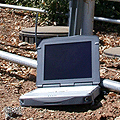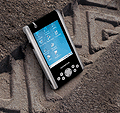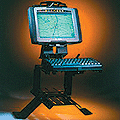|
Advantech ARK-1123 IoT gateway platform
Rugged, palm-size, fanless, quad-core and self-sensing Internet-of-Things gateway fits just about anywhere, under any conditions
(by Conrad H. Blickenstorfer; photography by Carol Cotton)
IPC stands for Industrial PC and IoT for Internet of Things, both terms not common in everyday language. "Industrial PC" generally evokes connotations of large, heavy-duty computing gear. What the "Internet of Things" is isn't quite clear just yet even to experts, though everyone agrees that it's going to be important, and quite possibly the next big thing. Advantech calls the ARK-1123 we're discussing in this review an IoT gateway, and it's certainly neither large nor heavy.

In fact, the ARK-1123 has about the footprint area of an iPhone 6 Plus, which makes it absolutely tiny for a rugged industrial computer. This little marvel measures just 5.3 x 3.7 inches and it's about 1.7 inches tall. Introduced towards the end of 2014, Advantech calls the ARK-1123 "palm-size" and that's not just marketing hype.

As for the ARK-1123 being an IoT gateway, what is the "Internet of Things," and why does Advantech consider it a major, must-pursue opportunity for OEMs and systems integrators in virtually every segment of commerce and industry?
First, the "Internet of Things" describes a paradigm where internet communication is no longer limited to people communicating with people or machines with machines. In the IoT paradigm, "things" communicate as well. These "things" may include anything that can collect data via sensors, and then pass that data on via a connection. "Things" may be vehicles, refrigerators, doors, locks, cameras, machines, sub systems, or entire homes or factories — anything
that can measure something and pass that data on for processing and feedback.
What benefits can the Internet of Things provide, and how big will be? The primary benefit is that completely connected, integrated and "intelligent" systems can provide a wealth of information that can make them work far better than before. IoT has the potential to greatly increase efficiency, reduce costs, and reduce risks. Cisco estimates that almost US$15 trillion in value is at stake between 2013 and 2022, measured as a combination of increased revenue and reduced cost. Gartner and ABI Research estimate that by 2020, up to 30 billion devices will be wirelessly connected to the Internet of Things.
 So what is an IoT gateway, and where does it fit in? Well, the Internet of Things is based on a quad-tier model (click the graphic to the right for a much larger version) with, from the bottom to the top: So what is an IoT gateway, and where does it fit in? Well, the Internet of Things is based on a quad-tier model (click the graphic to the right for a much larger version) with, from the bottom to the top:
- The wireless sensor network level with sensor "mote" edge devices that communicate via standard protocols.
- The embedded IoT gateway level that shares, filters, and transports data.
- The intelligent systems and networking level that manages and analyzes data and turns it into analytics action.
- The cloud where big data and IoT apps and services enable smart transportation, smart buildings, smart process automation, smart energy systems, and numerous other instant-feedback realtime services that were not possible before.
So the role of devices such as the ARK-1123 is to share, filter and transport data from all those sensors up to higher level intelligent systems and from there to the cloud. Filling the role of an IoT gateway requires small size, small power requirements, maximum reliability and ruggedness, multiple connectivity, and secure remote management. And that's precisely what Advantech's ARK-1123 is designed to do.
The image below shows the top view and all four side views of the ARK-1123. The device consists of a steel chassis the system board is mounted on, and a large U-shaped heat spreader with fins machined from solid aluminum. The heat spreader is a thing of beauty, and meticulously machined. It conducts the heat away from the CPU and related components and also dissipates additional heat through the device's metal frame, thus eliminating the need for a fan. Note the clean and purposeful design and execution that facilitates easy integration as well as painless maintenance.

The device is precision-engineered and exudes quality, like a fine Swiss watch. Everything makes sense, down to the smallest detail. Advantech even uses identical small Philips head screws throughout the device. Anyone who's serviced an electronic device just to find seven different screw types and sizes knows how important that is. Mounting options include DIN rail, VESA, and wall mount adapters.
In terms of functionality and connectivity, this super-compact full-function PC meets IoT gateway requirements, and also the requirements of any number of other deployments where small size matters. Our review ARK-1123H was configured to offer the following external ports:
- 2 x USB 2.0
- 1 x USB 3.0
- 1 x Serial RS232/422/485 (BIOS-selectable)
- 2 x RJ-45 gigabit LAN
- 2 x Antenna WiFi
- 4 x Antenna cut-outs
- Power (12 Volt DC)
- 2 x HDMI video
- Audio line-in and line-out
The ARK-1123 is designed to run off mSATA solid state storage via an internal half-size mini PCIe slot or a standard 2.5-inch hard disk. Our review unit came with a 320GB Seagate Momentus HD and ran Windows 7 Ultimate. The picture below shows once more just how small this Advantech IoT gateway is.
 The internal design of the ARK-1123 is actually quite complex. There are two small circuit boards on top of each other, each with the type of connectivity and expansion and slots and connectors you'd find on a standard PC motherboard. So despite its very small size, the ARK-1123's guts are not hyper-integrated and concentrated into a sliver of a circuit board as is the case, for example, in the iPad or a modern smartphone; no, this is a real PC. The internal design of the ARK-1123 is actually quite complex. There are two small circuit boards on top of each other, each with the type of connectivity and expansion and slots and connectors you'd find on a standard PC motherboard. So despite its very small size, the ARK-1123's guts are not hyper-integrated and concentrated into a sliver of a circuit board as is the case, for example, in the iPad or a modern smartphone; no, this is a real PC.
From a ruggedness standpoint, the enemy of embedded devices such as the ARK-1123 are usually temperature extremes and shock/vibration. Since they are not carried around, the drop spec and IP rating (sealing against solids and liquids) that in part define the durability of mobile devices are essentially irrelevant. As a result, there's no IP number and no drop spec, but a wide operating temperature range (-4 to 140 degrees Fahrenheit), as well as detailed shock and vibration test numbers. Note that Advantech differentiates between standard and extended temperature configurations, with extended temperature range models requiring special RAM and use of a solid state disk.
Advantech stresses that the ARK-1123 provides three times the performance of the predecessor ARK-1122 (which we also tested, see here). Whereas the older model used a dual-core 1.86GHz Intel Atom N2800, the ARK-1123H has a quad-core 2.0GHz "Bay Trail" processor with burst frequency up to 2.41GHz. This is a significantly more sophisticated chip employing 22nm process technology and integrated Intel HD Graphics. Despite the Celeron brand name, Bay Trail chips actually use an updated Atom processor architecture.
To provide an idea of the relative performance of the ARK-1123, we ran our two standard benchmark suites, PassMark and CrystalMark. For comparison, we're also listing the results of the ARK-1123's predecessor ARK-1122, as well as the also Celeron-powered ARK-3500, and the Core i7-based AIIS-1240 designed for automated optical inspection systems.
|
Advantech ARK-1123 IoT gateway Benchmarks and Comparisons
|
|
PERFORMANCE COMPARISON
|
Advantech
|
Advantech
|
Advantech
|
Advantech
|
|
Model
|
ARK-1123
|
ARK-1122
|
ARK-3500
|
AIIS-1240
|
|
Model (click pic for review)
|

|

|

|

|
|
Year tested
|
2015
|
2013
|
2015
|
2014
|
|
Intel processor
|
Celeron J1900
|
Atom N2800
|
Celeron 1020E
|
Core i7-3770
|
|
CPU base Speed
|
2.00GHz
|
1.86GHz
|
2.20GHz
|
3.40GHz
|
|
CPU turbo Speed
|
2.14GHz
|
no turbo
|
no turbo
|
3.9GHz
|
|
Cores/threads
|
4/4
|
2/2
|
2/2
|
4/8
|
|
Thermal Design Power (TDP)
|
10 watts
|
6.5 watts
|
35 watts
|
77 watts
|
|
Storage type
|
SATA hard disk.jpg
|
mSATA SSD
|
SATA hard disk
|
SATA hard disk
|
|
CPU Mark
|
2,023.4
|
546.1
|
2,198.0
|
8,820.9
|
|
2D Graphics Mark
|
181.4
|
NA
|
415.0
|
696.5
|
|
Memory Mark
|
444.2
|
254.3
|
923.3
|
1,420.5
|
|
Disk Mark
|
594.6
|
948.2
|
733.0
|
519.5
|
|
3D Graphics Mark
|
138.1
|
57.0
|
233.0
|
476.4
|
|
Overall PassMark
|
787.2
|
389.7
|
974.9
|
2,895.9
|
|
CM ALU
|
26,844
|
11,474
|
25,977
|
84,049
|
|
CM FPU
|
22,649
|
9,003
|
20,351
|
68,910
|
|
CM MEM
|
19,657
|
8,757
|
27,444
|
47,498
|
|
CM HDD
|
9,048
|
25,739
|
11,377
|
8,325
|
|
CM GDI
|
5,593
|
1,271
|
11,377
|
17,856
|
|
CM D2D
|
3,959
|
370
|
1,991
|
8,411
|
|
CM OGL
|
3,511
|
8,016
|
5,010
|
10,417
|
|
Overall CrystalMark
|
91,261
|
64,620
|
104,074
|
245,466
|
Now what do those numbers mean? First the comparison between the ARK-1122 and the successor ARK-1123. Advantech claims a 3X speed improvement, but the bottomline benchmark numbers show much less. Why? Because our test ARK-1122 had a speedy mSATA SSD whereas the ARK-1123 came with a conventional rotating hard disk. In terms of CPU performance, the new ARK-1123 is indeed about three times quicker. However, customers who need the full power and potential of this new compact IoT gateway should definitely uses SSD storage. SSD, however, is still considerably more expensive than standard hard disks, and since the ARK-1123H comes with dual HDMI ports, in many media-oriented applications it makes sense to go with the less expensive, higher capacity hard disk.
Interesting is the comparison between the ARK-1123 and the larger ARK-3500 designed for those who need PCI or PCIe expansion. The unit we tested in January 2015 came with the lowliest of four processor options, a dual-core Celeron 1020E based on Ivy Bridge technology. Though both of those chips are Celeron-branded, one uses Intel Atom and one Intel Core technology. So even though the Celeron J1900 in the ARK-1123 is a quad-core chip and the Celeron 1020E only a dual-core design, the 1020E's Core technology and standard voltage 35 watt TDP design provide more grunt.
As for comparison with the Core i7-3770 used in Advantech's optical inspection specialist AIIS-1240, well, that's a desktop-class 77 watt TDP high performance chip that's in an entirely different performance universe. It illustrates the importance of always carefully studying all available processor options and then pick the right one for the job.
 Are such processor options available for the ARK-1123H? No. It is not possible to offer a wide range of processor performance levels in such a small and fanless package due to the different thermal characteristics of different processors. There are, however, three different versions of the ARK1123 platform. In addition to the ARK-1123H we tested, there's the ARK-1123C that supports dual COM ports for factory/machine automation applications. It uses a lower-performance 1.3GHz dual-core Intel Atom E3825. There's also the ARK-1123L that has adds GPIO for advanced Input/Output control, and also uses the Atom E3825. Are such processor options available for the ARK-1123H? No. It is not possible to offer a wide range of processor performance levels in such a small and fanless package due to the different thermal characteristics of different processors. There are, however, three different versions of the ARK1123 platform. In addition to the ARK-1123H we tested, there's the ARK-1123C that supports dual COM ports for factory/machine automation applications. It uses a lower-performance 1.3GHz dual-core Intel Atom E3825. There's also the ARK-1123L that has adds GPIO for advanced Input/Output control, and also uses the Atom E3825.
Now where does the "intelligent self-sensing" come in? We're not talking artificial intelligence with plenty of sensors here. Instead, intelligent self-sensing is provided via integrated software services that provide self-management, in-time communications, protection and security. The system can perform real-time remote monitoring and has dynamic adjustment capabilities for internal parameters and externally linked devices. The ARK-1123 can also dispatch notifications and alarm messages to address impending system or peripheral failures. All of these functions are powered by Advantech's SUSIAccess software management services.
In summary, the three available configurations of the ARK-1123 provide a super-compact IoT gateway solution for numerous applications. It's economically priced, too. A bare-bones ARK-1123 starts at just US$555.
-- Conrad H. Blickenstorfer, April 2015
Advantech ARK-1123 Embedded Box PC Specs:
| Status |
Added 04/2015
|
| Type |
Embedded Box IPC
|
| CPU Type |
Quad-core 2.00GHz (2.41GHz burst frequency) Intel Celeron J1900
|
| Chipset |
Intel Atom SoC integrated
|
| BIOS |
AMI EFI 64 Mbit
|
| OS |
Windows Embedded Standard 7 (64-bit), Windows 7 Ultimate (64-bit)
|
| Memory |
Max 8GB DDR3 in 1 204-pin SODIMM socket |
| Graphics Controller |
Intel HD Graphics, 688MHz base, 854MHz max frequency |
| Thermal Design Power |
10 watts |
| Watchdog Timer |
255-level timer intervals, software setup |
| Graphics Interface |
2 x HDMI, up to 1920 x 1080 at 60Hz, dual independent displays |
| LAN |
2 x 10/100/1000 Mbps (Intel 82583V) LAN RJ45 |
| Storage |
1 x 2.5-inch SATA HD bay (max height 7mm), 1 x half-size Mini PCIe slot for mSATA storage module
|
| Housing |
Aluminum with optional DIN-rail, VESA and/or wall mounts
|
| Vibration |
With mSATA: 3 Grms, IEC 60068-2-64, random, 5 ~ 500 Hz, 1 Oct./min, 1hr/axis
With hard disk: 0.5 Grms, IEC 60068-2-64, random, 5 ~ 500 Hz, 1 Oct./min, 3 axes, 1hr/axis.
|
| Shock |
With mSATA: 30 G, IEC 60068-2-27, half sine, 11 ms duration
With hard disk: 10 G, IEC 60068-2-27, half sine, 11 ms duration
|
| EMC |
CE/FCC Class A, CCC, BSMI
|
| Safety |
CB, UL, CCC, BSMI
|
| Operating temperature |
With extended temp. SSD/mSATA/RAM: -4° to 140°F (-20° to °60C)
With standard temp. HDD/SSD/mSATA/RAM: 32° to 104°F (0° to °40C)
|
| USB |
2 x USB 2.0, 1 x USB 3.0
|
| Serial |
1 x RS232422/485 (BIOS selectable) serial |
| Audio |
HD Audio Realtek ALC-888S chipset, line-in + line-out jacks |
| Communication |
Optional via Mini PCIe with SIM card holder |
| DIO |
NA (available in ARK-1123L version) |
| Size |
5.27 x 3.7 x 1.7 inches (134 x 94 x 43 mm)
|
| Power |
12VDC via adapter (threaded connector)
|
| Price |
Starting at US$555 (see Advantech online store) |
| Webpage |
Advantech ARK-1123 page |
| Datasheet |
Advantech ARK-1123 |
Advantech Corporation
13 Whatney
Irvine, CA 92618
Toll Free: 1-800-866-6008
Ph: 949-420-2500
Fax: 949-420-2501
ISGinfo@advantech.com
www.advantech.com
Advantech Co. Ltd.
No.1, Alley 20, Lane 26, Rueiguang Road
Neihu District, Taipei Taiwan 114, R.O.C.
Tel: 886-2-2792-7818
Fax: 886-2-2794-7301
www.advantech.com
|














 So what is an IoT gateway, and where does it fit in? Well, the Internet of Things is based on a quad-tier model (
So what is an IoT gateway, and where does it fit in? Well, the Internet of Things is based on a quad-tier model (
 The internal design of the ARK-1123 is actually quite complex. There are two small circuit boards on top of each other, each with the type of connectivity and expansion and slots and connectors you'd find on a standard PC motherboard. So despite its very small size, the ARK-1123's guts are not hyper-integrated and concentrated into a sliver of a circuit board as is the case, for example, in the iPad or a modern smartphone; no, this is a real PC.
The internal design of the ARK-1123 is actually quite complex. There are two small circuit boards on top of each other, each with the type of connectivity and expansion and slots and connectors you'd find on a standard PC motherboard. So despite its very small size, the ARK-1123's guts are not hyper-integrated and concentrated into a sliver of a circuit board as is the case, for example, in the iPad or a modern smartphone; no, this is a real PC.




 Are such processor options available for the ARK-1123H? No. It is not possible to offer a wide range of processor performance levels in such a small and fanless package due to the different thermal characteristics of different processors. There are, however, three different versions of the ARK1123 platform. In addition to the ARK-1123H we tested, there's the ARK-1123C that supports dual COM ports for factory/machine automation applications. It uses a lower-performance 1.3GHz dual-core Intel Atom E3825. There's also the ARK-1123L that has adds GPIO for advanced Input/Output control, and also uses the Atom E3825.
Are such processor options available for the ARK-1123H? No. It is not possible to offer a wide range of processor performance levels in such a small and fanless package due to the different thermal characteristics of different processors. There are, however, three different versions of the ARK1123 platform. In addition to the ARK-1123H we tested, there's the ARK-1123C that supports dual COM ports for factory/machine automation applications. It uses a lower-performance 1.3GHz dual-core Intel Atom E3825. There's also the ARK-1123L that has adds GPIO for advanced Input/Output control, and also uses the Atom E3825.